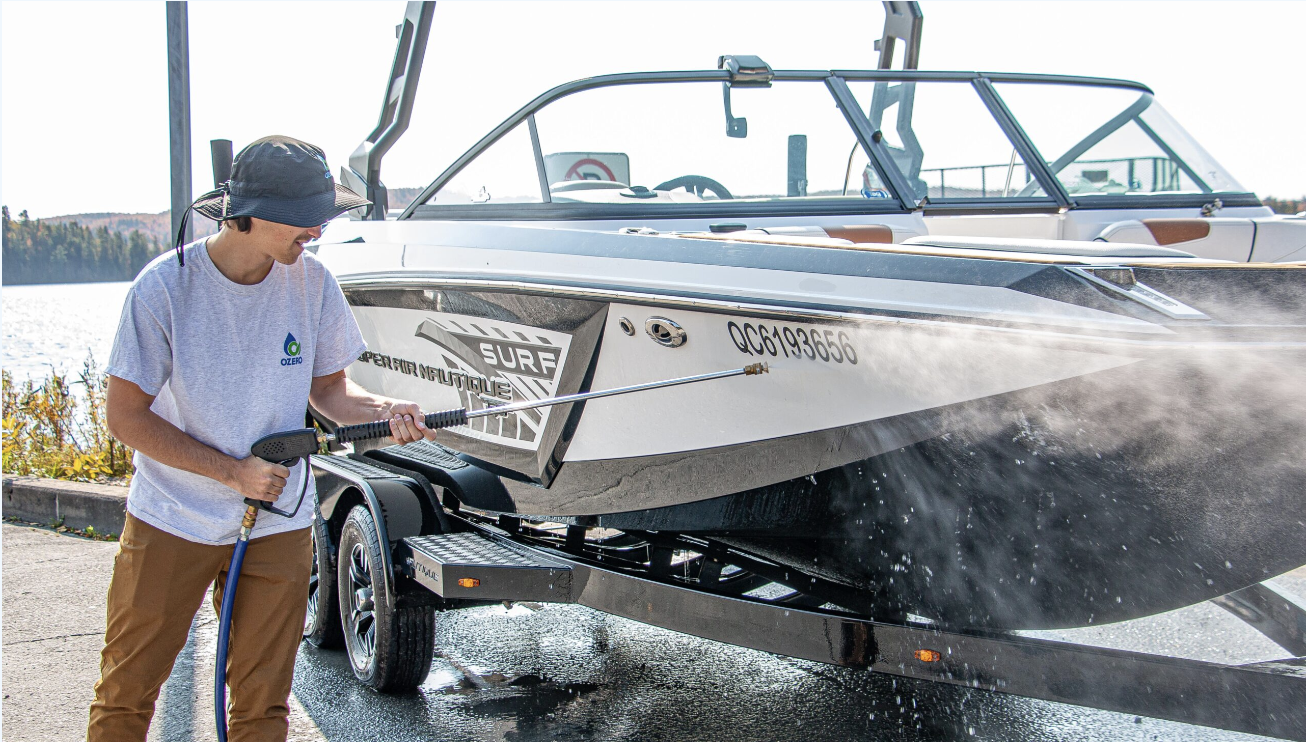WASHING YOUR BOAT: A SIMPLE GESTURE TO PROTECT OUR LAKES!

by Ozero Solutions | August 9, 2023 | Blog
Winter is finally over, and you have come out of hibernation to prepare for the upcoming boating season. Great news, right? But then you discover that your usual body of water is no longer accessible because your municipality has prohibited boating, water sports and swimming on hot summer days. It seems that the summer season is literally falling apart…what a catastrophic scenario for boating and water sports enthusiasts. But why…?
…because an invasive species has introduced itself and is colonizing your favourite lake. This happened because there was no watercraft decontamination or washing station. What happens when these species enter an ecosystem? They become invaders! And this is very dramatic for us and the environment!
SIGNIFICANT IMPACTS ON OUR COMMUNITY
It's a fact. Ninety percent of the time, aquatic invasive species are spread through pleasure boats or water activities, such as paddle boards, kayaks and canoes.
As they spread, these species can prevent navigation or swimming, which can have a direct impact on the value of properties bordering a body of water. It goes without saying that these are heavy financial losses!
This has a major impact on the environment. All biodiversity suffers, and sometimes certain species disappear or go completely extinct. Human health can also be affected by certain bacteria, risking serious illnesses. In the province of Québec, there’s an urgent need to act. Many lakes are contaminated, particularly in the Eastern Townships, the Chaudière-Appalaches region and in Central Québec.
DIFFERENT INVASIVE SPECIES NEAR YOU
Did you know that more than 50 invasive species colonize our majestic lakes? The most common are:
- Zebra mussels (damage boats and access to drinking water)
- Eurasian watermilfoil (an invasive plant that hinders water activities and swimming)
- Curly-leaf pondweed (exotic algae)
- European frogbit (a plant that floats on the surface of the water and reduces the amount of light and oxygen, leading to the suffocation of other natural species)
WASHING YOUR BOAT IS THE BEST SOLUTION
Any uncleaned boat that navigates a body of water is considered contaminated. It doesn’t matter if they’re motorized, on a trailer or a paddle boat, they must be cleaned at a washing station before being put into the water. Washing is THE best solution to prevent the introduction and contamination of invasive species, as they cling fiercely to your boat’s hull, propellers and piping as well as to your nautical equipment. Transmission occurs easily from one body of water to another, and this happens exponentially.
The costs associated with decontamination may make you hesitate. But you should know that this practice is in everyone’s interest. It will minimize the following damage:
- Obstructed drinking water intakes to cottages or power stations
- Decreased value of waterfront property (we don’t want that!)
- Hindered water navigation, swimming and fishing
- Damage to watercraft and their engines
- Significant costs associated with controlling exotic species
- Loss of essential habitats for local wildlife
HOW DOES A WATERCRAFT WASHING STATION WORK?
It’s quite simple! To properly decontaminate your watercraft, just follow the following 5 steps.
Step 1: Perform a 360° inspection of your trailer to remove plants, mud or visible residue.
Step 2: Drain any residual water from the hold, livewell, engine, ballast, etc.
Step 3: Clean all external and internal surfaces that may have been in contact with the body of water.
Step 4: Repeat these steps every time you visit a body of water.
Ozero Solutions' social mission is to protect the environmental, social and economic wealth of Québec's waterways. Our company has visited 23 lakes and decontaminated more than 552 boats with our units. However, awareness remains the crux of the matter. This is why our team takes concrete action on the ground by raising community awareness of the dramatic consequences that invasive aquatic spaces can cause.
Are you concerned about the condition of your region’s bodies of water and want to know what you can do about it?
Contact us!

